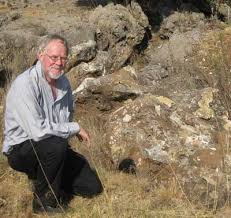The Impact that set the Earth on fire 12,800y ago - geological evidence now found also in the Southern Hemisphere
Research at University of Kansas shows that some 12,800 years ago, almost certainly following a cosmic impact, in the Younger Dryas event, an astonishing 10 percent of the Earth’s land surface, or about 10 million square kilometers, was consumed by fires.
New Evidence of Platinum spike found at Wonderkrater, in South Africa
A team of scientists from South Africa has discovered evidence partially supporting a hypothesis that Earth was struck by a meteorite or asteroid 12 800 years ago, leading to global consequences including climate change, and contributing to the extinction of many species of large animals at the time of an episode called the Younger Dryas.
The team, led by Professor Francis Thackeray of the Evolutionary Studies Institute at the University of the Witwatersrand in Johannesburg, South Africa, discovered evidence of a remarkable "platinum spike" at a site called Wonderkrater in the Limpopo Province, north of Pretoria in South Africa. Working with researcher Philip Pieterse from the University of Johannesburg and Professor Louis Scott of the University of the Free State, Thackeray discovered this evidence from a core drilled in a peat deposit, notably in a sample about 12 800 years old. This research was published in Palaeontologia Africana.
Noting that meteorites are rich in platinum, Thackeray said:
"Our finding at least partially supports the highly controversial Younger Dryas Impact Hypothesis (YDIH). We seriously need to explore the view that an asteroid impact somewhere on earth may have caused climate change on a global scale, and contributed to some extent to the process of extinctions of large animals at the end of the Pleistocene, after the last ice age."
Many mammals became extinct in North America, South America and Europe at the time of the Younger Dryas. In South Africa a few extraordinary large animal species became extinct, not necessarily at exactly 12 800 years ago, but close to that period. These megafauna include a giant African buffalo, a large zebra, and a very big wildebeest.
Human populations may also have been indirectly affected at the time in question. In North America there is a dramatic termination of the stone tool technology of Clovis people. Remarkably, archaeologists in South Africa have detected an almost simultaneous termination of the Robberg stone artefact industry associated with people in some parts of the country, including the area around Boomplaas near the Cango Caves in the southern Cape, close to the town of Oudshoorn.
"Without necessarily arguing for a single causal factor on a global scale, we cautiously hint at the possibility that these technological changes, in North America and on the African subcontinent at about the same time, might have been associated indirectly with an asteroid impact with major global consequences," says Thackeray. "We cannot be certain, but a cosmic impact could have affected humans as a result of local changes in environment and the availability of food resources, associated with sudden climate change."
At Wonderkrater, the team has evidence from pollen to show that about 12 800 years ago there was temporary cooling, associated with the "Younger Dryas" drop in temperature that is well documented in the northern hemisphere, and now also in South Africa. According to some scientists, this cooling in widespread areas could at least potentially have been associated with the global dispersal of platinum-rich atmospheric dust.
A large crater 31 kilometres in diameter has been discovered in northern Greenland beneath the Hiawatha Glacier.
"There is some evidence to support the view that it might possibly have been the very place where a large meteorite struck the planet earth 12 800 years ago," says Thackeray. "If this was indeed the case, there must have been global consequences."
Thackeray's team believes their discovery of a platinum spike at about 12 800 years ago at Wonderkrater is just part of the strengthening view that an asteroid or cometary impact might have occurred at that time.
This is the first evidence in Africa for a platinum spike preceding climate change. Younger Dryas spikes in platinum have also been found in Greenland, Eurasia, North America, Mexico and recently also at Pilauco in Chile. Wonderkrater is the 30th site in the world for such evidence.
"Our evidence is entirely consistent with the Younger Dryas Impact Hypothesis" says Thackeray.
The discovery in South Africa is expected to be integrated with those made in other parts of the world, recognising that the source of the platinum at Wonderkrater could hypothetically be cosmic dust that was dispersed in the atmosphere after a meteorite impact in Greenland.
The probability of a large asteroid striking Earth in the future may seem to be low, but there are thousands of large rocks distributed primarily between Jupiter and Mars. One in particular, classified as Apophis 99942, is referred to as a "Potentially Hazardous Asteroid." It is 340 meters wide and will come exceptionally close to the Earth in 10 years' time.
"The closest encounter will take place precisely on Friday April 13, 2029," says Thackeray. "The probability of the Apophis 99942 asteroid hitting us then is only one in 100,000, but the probability of an impact may be even higher at some time in the future, as it comes close to Earth every 10 years."
The South African research has been supported by the National Research Foundation and the DST/NRF Centre of Excellence for the Palaeosciences.
Go to the original article in The Science Daily, Oct. 2, 2019
Journal Reference: the scientific article in Palaeontologia Africana, 2019..

...and also in South America

In a paper published in the journal Nature Scientific Reports, James Kennett (picture), emeritus professor at University of Santa Barbara and colleagues, led by Chilean paleontologist Mario Pino, present further evidence of a cosmic impact, this time far south of the equator, that likely lead to biomass burning, climate change and megafaunal extinctions nearly 13,000 years ago.
“We have identified the YDB layer at high latitudes in the Southern Hemisphere at near 41 degrees south, close to the tip of South America,” Kennett said. This is a major expansion of the extent of the YDB event.” The vast majority of evidence to date, he added, has been found in the Northern Hemisphere.
This discovery began several years ago, according to Kennett, when a group of Chilean scientists studying sediment layers at a well-known Quaternary paleontological and archaeological site, Pilauco Bajo, recognized changes known to be associated with YDB impact event. They included a “black mat” layer, 12,800 years in age, that coincided with the disappearance of South American Pleistocene megafauna fossils, an abrupt shift in regional vegetation and a disappearance of human artifacts.
“Because the sequencing of these events looked like what had already been described in the YDB papers for North America and Western Europe, the group decided to run analyses of impact-related proxies in search of the YDB layer,” Kennett said.
This yielded the presence of microscopic spherules interpreted to have been formed by melting due to the extremely high temperatures associated with impact. The layer containing these spherules also show peak concentrations of platinum and gold, and native iron particles rarely found in nature.
“Among the most important spherules are those that are chromium-rich,” Kennett explained. The Pilauco site spherules contain an unusual level of chromium, an element not found in Northern Hemisphere YDB impact spherules, but in South America. “It turns out that volcanic rocks in the southern Andes can be rich in chromium, and these rocks provided a local source for this chromium,” he added. “Thus, the cometary objects must have hit South America as well.”
Other evidence, which, Kennett noted, is consistent with previous and ongoing documentation of the region by Chilean scientists, pointed to a “very large environmental disruption at about 40 degrees south.” These included a large biomass burning event evidenced by, among other things, micro-charcoal and signs of burning in pollen samples collected at the impact layer. “It’s by far the biggest burn event in this region we see in the record that spans thousands of years,” Kennett said. Furthermore, he went on, the burning coincides with the timing of major YDB-related burning events in North America and western Europe.
The sedimentary layers at Pilauco contain a valuable record of pollen and seeds that show change in character of regional vegetation — evidence of a shifting climate. However, in contrast to the Northern Hemisphere, where conditions became colder and wetter at the onset of the Younger Dryas, the opposite occurred in the Southern Hemisphere.
“The plant assemblages indicate that there was an abrupt and major shift in the vegetation from wet, cold conditions at Pilauco to warm, dry conditions,” Kennett said. According to him, the atmospheric zonal climatic belts shifted “like a seesaw,” with a synergistic mechanism, bringing warming to the Southern Hemisphere even as the Northern Hemisphere experienced cooling and expanding sea ice. The rapidity — within a few years — with which the climate shifted is best attributed to impact-related shifts in atmospheric systems, rather than to the slower oceanic processes, Kennett said.
Meanwhile, the impact with its associated major environmental effects, including burning, is thought to have contributed to the extinction of local South American Pleistocene megafauna — including giant ground sloths, sabretooth cats, mammoths and elephant-like gomphotheres — as well as the termination of the culture similar to the Clovis culture in the north, he added. The amount of bones, artifacts and megafauna-associated fungi that were relatively abundant in the soil at the Pilauco site declined precipitously at the impact layer, indicating a major local disruption.
The distance of this recently identified YDB site — about 6,000 kilometers from the closest well-studied site in South America — and its correlation with the many Northern Hemispheric sites “greatly expands the extent of the YDB impact event,” Kennett said. The sedimentary and paleo-vegetative evidence gathered at the Pilauco site is in line with previous, separate studies conducted by Chilean scientists that indicate a widespread burn and sudden major climate shifts in the region at about YDB onset. This new study further bolsters the hypothesis that a cosmic impact triggered the atmospheric and oceanic conditions of the Younger Dryas, he said.
“This is further evidence that the Younger Dryas climatic onset is an extreme global event, with major consequences on the animal life and the human life at the time,” Kennett said. “And this Pilauco section is consistent with that.”
Read the scientif article in pdf
This presentation is an excerpt from an article in Heritage Daily, March 14, 2019.
The impact that set the world on fire- The University of Kansas papers
Out of nowhere, the sky was lit with fireballs. This was followed by shock waves.
Fires rushed across the landscape, and dust clogged the sky, cutting off the sunlight. As the climate rapidly cooled, plants died, food sources were snuffed out, and the glaciers advanced again. Ocean currents shifted, setting the climate into a colder, almost “ice age” state that lasted an additional thousand years.
Finally, the climate began to warm again, and people again emerged into a world with fewer large animals and a human culture in North America that left behind completely different kinds of spear points.
This is the story supported by a massive study of geochemical and isotopic markers just published in the Journal of Geology.
The results are so massive that the study had to be split into two papers.
“Extraordinary Biomass-Burning Episode and Impact Winter Triggered by the Younger Dryas Cosmic Impact ~12,800 Years Ago” is divided into "Part One: Ice Cores and Glaciers” and “Part Two: Lake, Marine, and Terrestrial Sediments.”
The paper’s 24 authors include KU Emeritus Professor of Physics & Astronomy Adrian Melott and Professor Brian Thomas, a 2005 doctoral graduate from KU, now at Washburn University.
“The work includes measurements made at more than 170 different sites across the world,” Melott said.
“The hypothesis is that a large comet fragmented and the chunks impacted the Earth, causing this disaster,” said Melott. “A number of different chemical signatures — carbon dioxide, nitrate, ammonia and others — all seem to indicate that an astonishing 10 percent of the Earth’s land surface, or about 10 million square kilometers, was consumed by fires.”
News release of University of Kansas (02/01/2018)“Computations suggest that the impact would have depleted the ozone layer, causing increases in skin cancer and other negative health effects,” Melott said. “The impact hypothesis is still a hypothesis, but this study provides a massive amount of evidence, which we argue can only be all explained by a major cosmic impact.”
Mammoths survived on Wrangel Island until 4,000y ago

The Younger Dryas event is considered to be at the origin of the extinction of the mammoths. Surprisingly, a population of mammoths has been found to have survived on the Russian Arctic island of Wrangel, until 4,000 years ago, when these last remnants of the species disappeared for good in another environmental catastrophe.
The scientific article in Quaternary Science Review (October 15, 2019)


Fifty years ago, Alfred de Grazia was already advocating a Guaranteed Basic Income
We are supporting


